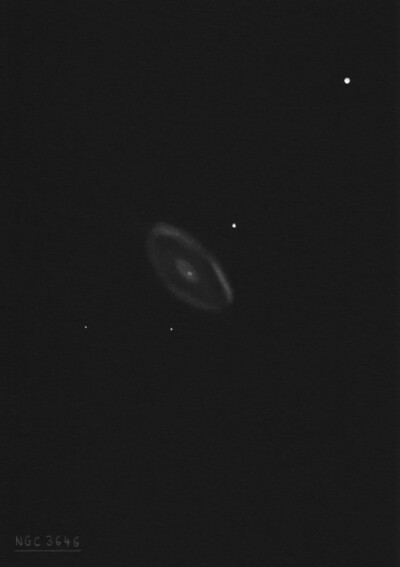
William Herschel discovered NGC 3646 = H III-15 = h866 on 15 Feb 1784 (sweep 146) and recorded "Two, a Large nebula [NGC 3646] followed by a small one [NGC 3649], in the same field of view with it. The large one is extremely and small one still fainter, so that I did not perceive it immediately. I suppose the large one cannot be less than 5 or 6' of extent." JH logged "F; L; E; 2' long. The sp of two [with[NGC 3649]."
Bindon Stoney, observing with LdR's 72" on 13 Apr 1852, remarked "L neb [NGC 3646] is bM. It has a knot in sp end and a dark curved passage on p and n sides of centre; Spiral." This description is similar to the view in Jimi Lowrey's 48".
300/350mm - 13.1" moderately bright and large, elongated, broad concentration with no nucleus. An extremely faint star or knot is involved.
400/500mm - 17.5" (4/14/01): moderately bright, fairly large, elongated 3'x2' SW-NE. Gradually increases to a brighter 30" oval core. A quasi-stellar nucleus is occasionally visible with direct vision. Forms a pair with NGC 3649 7.8' ENE.
900/1200mm - 48" (5/16/12 and 4/6/13): this showpiece spiral appeared bright, large, oval ~2:1 SW-NE, sharply concentrated with a very bright core. The visual treat was a prominent lens or eye-shaped ring surrounding the core! The ring was slightly brighter in an arc along the north side. At the west edge of this arc was a very faint quasi-stellar knot (SDSS J112141.34+201039.0, V = 17.2). Another section of the ring that stands out is along the southwest edge, with a brighter linear piece about 40" long that has several SDSS designations. The interior of the ring is fairly dark near this section, as well as other sections, providing a good contrast between the core and ring. A very small, weak brightening was also noted on the northeast end of the ring. A mag 14 star lies 1.4' NW of center and a mag 16 star is 1' SSE of center.
Notes by Steve Gottlieb